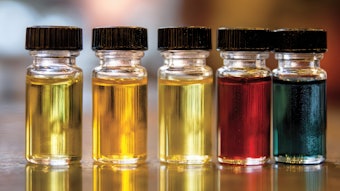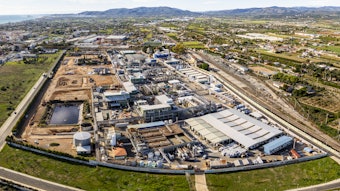
Fragrance ingredients such as essential oils, extracts, aroma compounds and solvents are included in a variety of products such as fine fragrance, personal Jordan Turner, Marketing Coordinator, SGS BetaCourtesy of SGS Beta
Jordan Turner, Marketing Coordinator, SGS BetaCourtesy of SGS Beta
This article is only available to registered users.
Log In to View the Full Article
Fragrance ingredients such as essential oils, extracts, aroma compounds and solvents are included in a variety of products such as fine fragrance, personal Jordan Turner, Marketing Coordinator, SGS BetaCourtesy of SGS Beta
Jordan Turner, Marketing Coordinator, SGS BetaCourtesy of SGS Beta
Along with higher consumer demand for natural-sourced ingredients as a result of sustainability concerns comes an increase in customer scrutiny when it comes to ingredient transparency and authenticity. This presents an important challenge for companies who need a solution for supporting label claims and ensuring their ingredients are genuinely natural-sourced and unadulterated.
Natural ingredient testing via carbon-14 analysis stands out in the industry as an accurate third-party tool for verifying bio-based or natural-sourced fragrance ingredients.
Key Concepts in Natural Ingredient Testing
Natural ingredient testing measures the isotope carbon-14, or radiocarbon, via an Accelerator Mass Spectrometer (AMS) instrument. This well-established methodology allows for the authentication of biobased fragrance ingredients according to international standards ASTM D6866 and ISO 16620-2. Results reveal the percentage of biobased (natural) carbon versus synthetic (fossil) carbon ingredients in a sample.
A result of 100% biobased indicates an ingredient is completely natural-sourced while any percentage between 1% and 99% indicates the presence of synthetic petrochemical-derived components. An ingredient that is 0% biobased is therefore completely synthetic.
This method is highly effective as natural components possess known levels of carbon-14 while synthetics do not contain any.2 Thus, this method clearly identifies whether an ingredient claiming to be 100% natural has been adulterated.
Maintaining Ingredient Authentication & Integrity
Determining the bio-based percentage of an ingredient has several benefits when it comes to ensuring ingredient authenticity and supply chain integrity. These benefits include validation of natural content, providing data for quality control of raw materials and identifying adulterated ingredients. Economically-motivated adulteration is the intentional omission, addition or substitution of an ingredient.3 Motivations for adulteration of botanical raw materials are due to high cost, high demand and limited supply.4
Analytical methods such as gas chromatography-mass spectrometry (GC-MS) and isotope ratio mass spectrometry (IRMS) are unable to differentiate between natural and synthetic ingredients due to chemical similarities between the two. However, natural ingredient testing is based on the presence or absence of carbon-14, making it an accurate tool to detect synthetic adulterants.5
 This method is highly effective as natural components possess known levels of carbon-14 while synthetics do not contain any.dadakko at Adobe Stock
This method is highly effective as natural components possess known levels of carbon-14 while synthetics do not contain any.dadakko at Adobe Stock
The Value of Natural Ingredient Testing: Industry Insights
Natural ingredient testing is a valuable third-party tool for validating ingredient integrity, serving several purposes for natural product distributors and manufacturers. The aforementioned consumer shift toward the preference for sustainable products and ingredient transparency prompts industry leaders to develop clean-label fragrances. Additionally, the demand for ingredients that are ethically and sustainably sourced lead ingredient suppliers to seek innovation when it comes to formulation strategies and sourcing practices.
According to Vivek Mehrotra, chief executive officer of Khattri Aromas LLP, carbon-14 testing is beneficial for ensuring the natural source of fragrance ingredients as fragrance industry trends evolve over time. Essential oils such as patchouli, lavender, rose, menthol, vetiver and citrus oils each pose their own unique challenges including overharvesting, oxidization, vulnerability to adulteration and other issues. Making sure ingredients are of consistent quality while preserving natural integrity is fundamental to the manufacturing and distribution process.
There are several strategies industry professionals can use to keep up with customer preferences and industry trends. These include investing in research, technology and market analysis as well as keeping up with client feedback to ensure efforts to meet consumer needs remain agile and responsive to industry changes.
Customers want to know where their fragrance ingredients come from and whether they were ethically sourced and sustainably harvested. These strategies, paired with reliable third-party analysis like natural ingredient testing, are key to staying ahead of the challenges posed by changing trends within the industry.
Targeting Industry Challenges
As the fragrance industry experiences future developments and innovations, Natural ingredient testing via carbon-14 analysis is one protocol that can be implemented in response to the developments and challenges the fragrance industry faces. producer at Adobe Stock
Natural ingredient testing via carbon-14 analysis is one protocol that can be implemented in response to the developments and challenges the fragrance industry faces. producer at Adobe Stock
These factors contribute to the practice of economically-motivated adulteration of naturally sourced fragrance ingredients. Adulteration is a persistent challenge and concern for industry professionals. As the prices of natural raw materials increase, some ingredient suppliers may engage in unscrupulous practices such as dilution or extension of essential oils with cheaper ingredients or synthetic substitutes. For this reason, the detection and verification of natural sourced ingredients is critical.
Natural ingredient testing via carbon-14 analysis is one protocol that can be implemented in response to the developments and challenges the fragrance industry faces. Mr. Mehrotra says that investing in supplier education, implementing strict vetting procedures, and fostering long-term partnerships based on transparency are also key. Industry-wide collaboration on traceability standards and ethical sourcing certifications can further reinforce supply chain integrity.
Carbon-14 natural ingredient testing is one of the methods that can be used to distinguish between bio-based and synthetic fragrance components. In particular, analyzing essential oils that are labeled as 100% natural has successfully detected synthetic adulteration.6 Essential oils such as sandalwood, rose, and lavender oils, are particularly susceptible to adulteration in various forms from simple dilution to complex mimicry of natural ingredients with synthetic alternatives. Despite the prevalence of adulteration, natural ingredient testing allows for the identification of inconsistencies early on in their formulation process. With this assurance, companies can confidently present their ingredients as naturally sourced to their customers and reinforce the integrity of their supply chain.
Conclusion
Carbon-14 analysis is a valuable tool that identifies the percentage of natural-sourced versus synthetic content of fragrance ingredients. Established industry professionals count natural ingredient testing among their top strategies to ensure transparency, sustainability, and authenticity of ingredients. In particular, carbon-14 testing is instrumental when it comes to responding to challenges such as sourcing difficulties and defending brand integrity in the face of economically-motivated adulteration.
References
1. Sawal J. Natural Fragrance Market Size, Share, Trend Analysis By 2033. [Internet]. Emergen Research. 2025 Jan. [cited 2025 Jul 21].
2, 6. Gershon H. Authentication of Natural Peppermint Oil. [Internet]. Perfumer & Flavorist. Vol. 44:22-25. 2019 Mar. [cited 2025 Jul 21].
3. U.S. Food and Drug Association. Economically Motivated Adulteration (Food Fraud). [Internet]. U.S. FDA. 2024 Apr. [cited 2025 Jul 21].
4. Gafner S, Blumenthal M, Foster S, Cardellina JH 2nd, Khan IA, Upton R. Botanical Ingredient Forensics: Detection of Attempts to Deceive Commonly Used Analytical Methods for Authenticating Herbal Dietary and Food Ingredients and Supplements. Journal of Natural Products. Vol.86(2):460-472. 2023 Feb. [cited 2025 Jul 21].
5. SGS Beta. Verifying Natural Products: Is Carbon-14 Analysis Necessary?. [Internet]. SGS Beta. 2018 Apr. [cited 2025 Jul 21].










